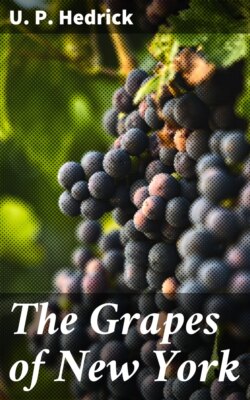Читать книгу The Grapes of New York - U. P. Hedrick - Страница 49
VITIS AESTIVALIS BOURQUINIANA Bailey.[146]
Оглавление1. Garber, Gar. Mon., 1:75. 1859. 2. Engelmann, Bush. Cat., 1883:16. (Varieties of southern origin). 3. Bush, Ib., 1883:23. Southern Aestivalis. 4. An. Hort., 1889:101. V. Bourquina. 5. Munson, Gar. and For., 3:474, 475. 1890. V. Bourquiniana; Southern Aestivalis. 6. Ib., U. S. D. A. Pom. Bul., 3:12. 1890. V. Bourquiniana. 7. Ib., Am. Gard., 12:584. 1891. V. Bourquiniana; Southern Aestivalis. 8. Popenoe and Mason, Kan. Sta. Bul., 44:117. 1893. V. Bourquiniana. 9. Munson, Bush. Cat., 1894:20, 22, 27. V. Bourquiniana; Southern Aestivalis. 10. Husmann, 1895:6, 8. V. Bourquiniana. 11. Munson, Tex. Farm and Ranch, Feb. 8, 1896:10. V. Bourquiniana; Southern Aestivalis. 12. Bailey, Gray’s Syn. Fl., 1:428. 1897. 13. Ib., Ev. Nat. Fr., 1898:81, 83, 114. 14. Munson, Am. Gard., 20:1688. 1899. V. Bourquiniana. 15. Ib., Tex. Sta. Bul., 56:231, 240, 261. 1900. V. Bourquiniana; Southern Aestivalis. 16. Viala and Ravaz, Am. Vines, 1903:178. V. Bourquiniana.
Bourquiniana greatly resembles Aestivalis and differs chiefly from this species in having thinner leaves and in that the shoots and under side of the leaves are only slightly reddish-brown in color and the pubescence usually disappears at maturity; this pubescence is mostly of an ashy or dun color. The leaves on some of the vines are more deeply lobed than is at all common in Aestivalis. The fruit is considerably larger than that of Aestivalis, sweeter and more juicy.
The botanical variety, Bourquiniana, is known only in cultivation. It is mentioned by Garber in 1859 and by Engelmann in 1883. Speaking of Aestivalis the latter says: “Unfortunately the typical forms cannot be propagated by cuttings and there are a number of varieties which, originating from a southern home, are not quite hardy here but on the other hand have the advantage of being readily propagated by slips in some favorable localities. * * * Unfortunately no wild plant from which these varieties might have sprung is yet known but must be looked for in the mountains and hills of the Carolinas and Georgia and only when found in a wild state can we correctly judge of their botanical status.”
The name Bourquiniana was given by Munson, who ranks the group as a species. He includes therein many southern varieties the most important of which are: Herbemont, Bertrand, Cunningham, and Lenoir, these he groups in the Herbemont section; and Devereaux, Louisiana and Warren, he puts in the Devereaux section. Munson has traced the history of this interesting group and states that it was brought from southern France to America over 150 years ago by the Bourquin family of Savannah, Georgia. Many botanists have been of the opinion that Bourquiniana is a hybrid. Engelmann says: “I will only state here that a slight suspicion exists of their being hybrids between V. aestivalis and some form of vinifera though the seeds are entirely those of the former and also the resistance to phylloxera.” Millardet considers Bourquiniana to be a mixed hybrid of Aestivalis, Cinerea and Vinifera. The hybrid supposition is certainly corroborated to a degree at least by the characters being more or less intermediate between the parent species and also by the fact that up to date no wild form of Bourquiniana has been found.
Munson’s derivation of the origin has not been accepted by either French or American botanists. In this connection Bailey says: “It is unassumable that a native grape distributed through the Mediterranean region could have escaped for centuries the critical search of European botanists and the knowledge of hundreds of generations of vignerons to be discovered at last transplanted in the new world.” Bush says: “This reminds us forcibly of the ‘Pedro Ximenes’ (called also White Green Riesling), which was believed to have been brought to Spain from the banks of the Moselle by the man whose name it bears.” Count Odart, a celebrated ampelograph, wittily said: “If he (Ximenes) took any he took ALL, for no such vine grows now north of the Pyrenees.’ Thus we also think: If Mr. Bourquin took any of the above grapes he took ALL, for no Herbemont or Lenoir can now be found native in Europe.”
The only northern variety of grape of any importance that is supposed to have Bourquiniana blood is the Delaware,[147] and in this case only a fraction of Bourquiniana blood is presumably present.
Bourquiniana can be propagated from cuttings more easily than the typical Aestivalis but not so readily as Labrusca, Riparia or Vinifera. Many of the varieties of Bourquiniana show a marked susceptibility to mildew and black-rot; in fact, the whole Herbemont group is much inferior in this respect to the Norton group of Aestivalis. The roots are somewhat hard, branch rather freely and are quite resistant to phylloxera.
